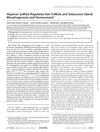TLDR Infrared spectral imaging can effectively study protein distribution in hair follicles during hair growth.
The study "Investigation of Glypican-4 and -6 by Infrared Spectral Imaging during the Hair Growth Cycle" analyzed the distribution of glypican-4 (GPC4) and glypican-6 (GPC6) in hair follicles during different phases of the hair growth cycle using infrared spectral imaging (IRSI) and Western blot assays. The research involved four donors with two to three hair samples each. The study found that GPC4 and GPC6 are mainly detected in the germinative area of the hair matrix and in the inner root sheath for all phases of the cycle, with an increased correlation in the telogen phase. The different forms of GPC4 and GPC6 were more abundant in hair follicles in the telogen phase. The findings suggest that GPC4 could be an indicator for monitoring the differentiation of stem cells, and GPC6 may play a role in the formation of the secondary hair germ and thus in hair follicle stem cell differentiation. The study concludes that IRSI could be a promising technique to study alopecia.
9 citations
,
January 2021 in “Biomolecules” Infrared spectral imaging can map hair growth proteins and sugars without staining.
 10 citations
,
May 2020 in “Dermatology Research and Practice”
10 citations
,
May 2020 in “Dermatology Research and Practice” Proteoglycans are important for hair growth, and a specific treatment can help reduce hair loss.
 42 citations
,
July 2014 in “Journal of biological chemistry/The Journal of biological chemistry”
42 citations
,
July 2014 in “Journal of biological chemistry/The Journal of biological chemistry” Heparan sulfate is important for hair growth, preventing new hair formation in mature skin, and controlling oil gland development.
 106 citations
,
March 2014 in “BioEssays”
106 citations
,
March 2014 in “BioEssays” We need more research to better understand human hair follicle stem cells for improved treatments for hair loss and skin cancer.
 15 citations
,
September 2006 in “Journal of International Medical Research”
15 citations
,
September 2006 in “Journal of International Medical Research” Nourkrin® significantly increased hair growth and was well-tolerated by people with hair loss.
550 citations
,
December 2005 in “The Journal of clinical investigation/The journal of clinical investigation” Researchers successfully isolated and identified key markers of stem cell-enriched human hair follicle bulge cells.
 21 citations
,
May 2022 in “Frontiers in Cell and Developmental Biology”
21 citations
,
May 2022 in “Frontiers in Cell and Developmental Biology” Hair growth and health are influenced by factors like age, environment, and nutrition, and are controlled by various molecular pathways. Red light can promote hair growth, and understanding these processes can help treat hair-related diseases.
21 citations
,
May 2016 in “Experimental and Therapeutic Medicine” MMP-2 and MMP-9 help hair grow, while their inhibitors peak when hair growth slows.
158 citations
,
February 2012 in “Journal of Investigative Dermatology” 95 citations
,
July 2006 in “British Journal of Dermatology” Vitamin D receptors in hair follicles change with the hair cycle, affecting hair growth.




